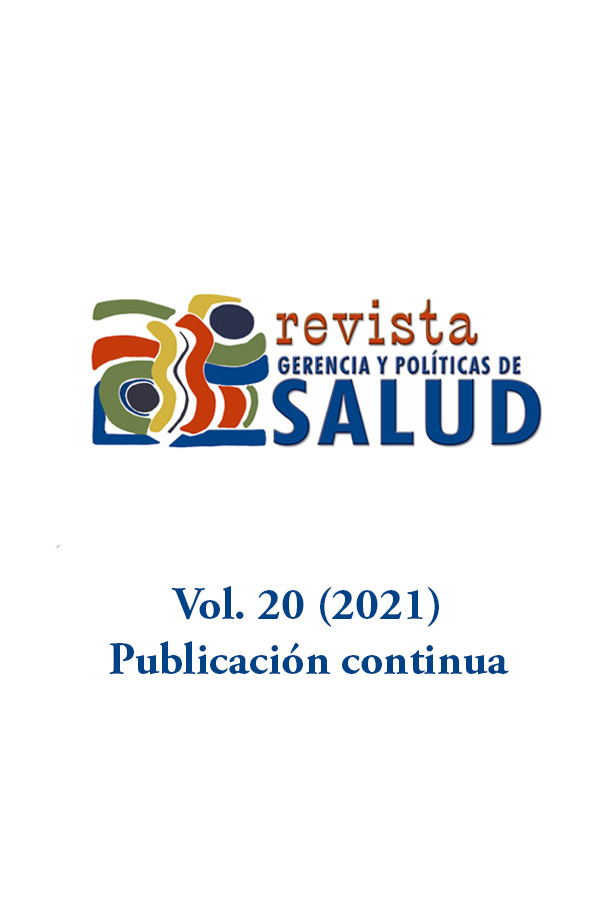Abstract
Introduction. The consumption of products derived from tobacco is one of the principal causes of preventable death, and the gap in consumption between men and women is getting smaller and smaller. Objective. Describe the strengths and/or limitations of the implementation of programs directed at the prevention and control of consumption of tobacco products by women in Antioquia, Colombia. Methods. Qualitative research, through 30 semi-structured interviews applied in the Department’s nine sub-regions. The categories of analysis were built around the continuum for the control of tobacco (prevention, cessation, secondhand smoke, and public policies). Content analysis was used for the results. Results. Antioquia has barriers to the effective application of programs for the prevention, control and cessation of tobacco consumption, such as lack of funding, greater focus on programs related to psychoactive substances, tobacco industry marketing, limitations in health benefits plans to access the treatment, and little articulation between the health sector and education, culture, sports and community actors. In addition, there is little awareness, diffusion, or enforcement of Law 1335. Participants report not knowing about strategies differentiated by gender. Conclusion. In the continuum for the control of tobacco, there are different factors that constitute limits for the establishment and development of new programs for the prevention and control of tobacco consumption by women in Antioquia. In addition, a differential gender focus was not found.
Reitsma MB, Fullman N, Ng M, Salama JS, Abajobir A, et al. Smoking prevalence and attributable disease burden in 195 countries and territories, 1990-2015: A systematic analysis from the Global Burden of Disease Study 2015. Lancet. 2017;389(10082):1885-1906. https://doi.org/10.1016/S0140-6736(17)30819-X
Drope J, Schluger N, Cahn Z, Drope J, Hamill S, et al. The Tobacco Atlas, 6th ed. Atlanta: American Cancer Society and Vital Strategies; 2018. https://tobaccoatlas.org/wp-content/uploads/2018/03/TobaccoAtlas_6thEdition_LoRes_Rev0318.pdf
Organización Panamericana de la Salud. Informe sobre el control del tabaco en la Región de las Américas, 2018. Washington DC: OPS. http://www.ipsuss.cl/ipsuss/site/artic/20180829/asocfile/20180829181403/informe_control_del_tabaco_america_2018.pdf
Bardach A, García HA, Ruano RA, Ciapponi A. Niveles de ingreso y prevalencia de tabaquismo en América Latina: revisión sistemática y metaanálisis. Rev Panam Salud Publica. 2016;40(4):263-271. https://iris.paho.org/bitstream/handle/10665.2/31309/v40n4a12_263-71.pdf?sequence=1&isAllowed=y
Sánchez J, Lira Mandujano J. Revisión sobre los factores relacionados con el consumo de tabaco en la mujer. Caleidoscopio - Revista Semestral de Ciencias Sociales y Humanidades. 2016;19(34):95-118. https://doi.org/10.33064/34crscsh163
Centro para el Control y la Prevención de Enfermedades, CDC. Las mujeres y el tabaquismo. Informe de la dirección general de salud pública; 2001. https://www.cdc.gov/spanish/tabaco/Spanishwom03.pdf
Sánchez S. El consumo de tabaco como símbolo de libertad femenina: análisis de las estrategias publicitarias utilizadas por Virginia Slims. Trabajo de grado. Universidad de Valladolid; 2018. http://uvadoc.uva.es/handle/10324/29340
Colombia. Ministerio de Justicia y del Derecho - Observatorio de Drogas de Colombia y el Ministerio de Salud y Protección Social. Estudio Nacional de Consumo de Sustancias Psicoactivas en Colombia; 2013. https://www.unodc.org/documents/colombia/2014/Julio/Estudio_de_Consumo_UNODC.pdf
Colombia. Ministerio de Salud y Protección Social. Encuesta Nacional Tabaquismo en Jóvenes 2018. https://untobaccocontrol.org/impldb/wp-content/uploads/ENTJ-Colombia-2016.pdf
World Health Organization. WHO Framework Convention on Tobacco Control, 2003. https://apps.who.int/iris/bitstream/handle/10665/42811/9241591013.pdf;jsessionid=9D671400300D6A9501AEBA121B2D8C59?sequence=1
Research on International Tobacco Control. Setting tobacco control research priorities for Latin America and the Caribbean: Past, present, and future; 2007. https://idl-bnc.idrc.ca/dspace/handle/10625/44304
Colombia. Congreso de la República. Ley 1335 de 2009 por la cual se dictan disposiciones por medio de las cuales se previenen daños a la salud de los menores de edad, la población no fumadora y se estipulan políticas públicas para la prevención del consumo del tabaco y el abandono de la dependencia del tabaco del fumador y sus derivados en la población colombiana. Diario Oficial, 47417 (Jul 21 de 2009).
Amos A, Greaves L, Nichter M, et al. Women and tobacco: A call for including gender in tobacco control research, policy and practice. Tobacco Control. 2012;21:236-243. http://dx.doi.org/10.1136/tobaccocontrol-2011-050280
Bottorff JL, Haines-Saah R, Kelly MT, Oliffe JL, Torchalla I, Poole N, et al. Gender, smoking and tobacco reduction and cessation: A scoping review. Int J Equity Health. 2014;13(114). https://doi.org/10.1186/s12939-014-0114-2
Krippendorff, K. Content analysis: An introduction to its methodology, 2nd ed. Thousand Oaks, CA: Sage Publications; 2004.
Pérez MA, Pinzón-Pérez H. Uso del tabaco entre los jóvenes colombianos. Retos para los profesionales en salud pública. Salud Uninorte. 2005;21(2):66-75. http://rcientificas.uninorte.edu.co/index.php/salud/article/viewArticle/4112/5494
Ruíz Morí E, Ruíz Morí H, Salazar-Rojas R, Torres-Mallma C, Valer-Villanueva S, et al. Conocimiento de los riesgos del tabaquismo en fumadores, exfumadores y no fumadores. Horiz Med. 2016;16(1):32-37. http://www.scielo.org.pe/pdf/hm/v16n1/a05v16n1.pdf
Chávez R, López F, Regalado J, Espinosa M. Consumo de tabaco, una enfermedad social. Rev Inst Nal Enf Resp Méx. 2004;17(3):204-214. http://www.scielo.org.mx/scielo.php?script=sci_arttext&pid=S0187-75852004000300007&lng=es
Defensoría del Pueblo. Informe de seguimiento al cumplimiento del convenio marco de la OMS para el control de tabaco en Colombia, 2017. http://www.defensoria.gov.co/public/pdf/Informe_tabaco.pdf
Panader-Torres A, Agudelo-Cely N, Bolivar-Suárez Y, Cárdenas-Cárdenas L. Control del tabaco: una experiencia desde la intersectorialidad en Tunja (Colombia). Gaceta Sanitaria. 2014;28(6):508-510. https://doi.org/10.1016/j.gaceta.2014.05.012
Wiesner C, Peñaranda D. Encuesta mundial de tabaquismo en Jóvenes. Reporte de Bogotá, Colombia, 2002. https://extranet.who.int/ncdsmicrodata/index.php/catalog/389/download/3006
Rodríguez MA. Los profesionales de la salud y la prevención y control del tabaquismo. Rev Fac Nac Salud Pública. 2010;28(1):81-88. https://www.redalyc.org/articulo.oa?id=12016345011
Instituto de Efectividad Clínica y Sanitaria, IECS. Carga de enfermedad atribuible al tabaquismo en Colombia, 2013. https://www.iecs.org.ar/wp-content/uploads/Carga-de-enfermedad-tabaquismo-Colombia-NOV2013-IECS-Doc-Tec-N%C2%B0-9-1.pdf
Isea EE, Alfonso IV, Naranjo JC. Diseño de un programa para la cesación del consumo de tabaco y atención del tabaquismo en Javesalud IPS. Bogotá: PUJ; 2017. https://repository.javeriana.edu.co/handle/10554/39677
Alba LH, Murillo R, Becerra N, Páez N, Cañas A, et al. Recomendaciones para la cesación de la adicción al tabaco en Colombia. Biomédica. 2013;33(2):186-204. http://dx.doi.org/10.7705/biomedica.v33i2.651
Leal-López E, Sánchez-Queija I, Moreno C. Tendencias en el consumo de tabaco adolescente en España, 2002-2018. Adicciones. 2019;20(10):289-297. http://dx.doi.org/10.20882/adicciones.1111
Bianco E. Las estrategias para el control del tabaco y su racionalidad. Urug Cardiol. 2005;20(3):171-219. http://www.scielo.edu.uy/pdf/ruc/v20n3/v20n3a06.pdf
Valdés-Salgado R, Hernández-Ávila M, Sepúlveda-Amor J. El consumo de tabaco en la Región americana: elementos para un programa de acción. Salud Pública de Méx. 2002;44(1):S125-S135. http://www.scielo.org.mx/pdf/spm/v44s1/a18v44s1.pdf

This work is licensed under a Creative Commons Attribution 4.0 International License.
Copyright (c) 2021 Jennifer Marcela López Ríos, Isabel Cristina Scarinci, Isabel Cristina Garcés Palacio


